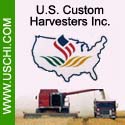 |
 |

|
|
|
South Dakota Ag News Headlines |
 |
When Should a Fungicide Be Applied?
South Dakota Ag Connection - 05/26/2016
Moderate levels of some wheat leaf diseases are developing in South Dakota due to the rains the state has received this spring.
"The most notable diseases are powdery mildew (Fig. 1), stripe rust, and tan spot," said Emmanuel Byamukama, Assistant Professor & SDSU Extension Plant Pathologist. "Some producers are wondering whether to apply a fungicide now that wheat is at flag
leaf growth stage, or wait and apply when the wheat is at flowering to manage both the leaf diseases and Fusarium head blight."
The answer to this question Byamukama said depends on a number of factors including:
-- The prevalence of diseases that are currently being observed on the top wheat leaves;
-- The susceptibility of the cultivar planted; and
-- Current weather and near future forecast.
"Fungicide application can be delayed until flowering if the leaf below flag leaf is having no fungal lesions (powdery mildew, tan spot or rust)," Byamukama said.
He added that fungicides should be applied when two to three lesions of powdery mildew and one to two of tan spot or Stagonospora blotch are seen on the leaf below flag leaf or rust pustules are seen on the flag leaf.
"One limitation of applying a fungicide at flag leaf if wet and humid weather occurs during wheat flowering is that there might be a need for another fungicide application to manage Fusarium head blight," he said.
Multiple application of fungicides close to each other may not necessarily be profitable. "Moreover, some fungicides are limited in terms of the maximum product that can be applied on a crop in the same season," Byamukama said. "If there is limited disease
pressure at flag leaf growth stage, a fungicide can be delayed and applied at flowering."
He explained that the flag leaf is the biggest contributor to yield and therefore fungicide application should aim at protecting this leaf.
"Research completed by researchers at the University of Minnesota indicated that delaying a fungicide application until flowering did not compromise control of fungal leaf disease or yield in eight spring wheat cultivars," he said.
Byamukama added that research done at South Dakota State University also indicated limited differences in yield for plots that received a fungicide at flag leaf and those at flowering.
"I encourage growers to scout their wheat fields to determine the level of disease at flag leaf growth stage; if the flag leaf and the leaf below flag leaf are relatively free of fungal diseases, consider delaying fungicide application until flowering," Byamukama said.
Other South Dakota Headlines
|
|
 |


|
 |
|
Copyright © 2024 - Farms.com. All Rights Reserved. |
 |
|